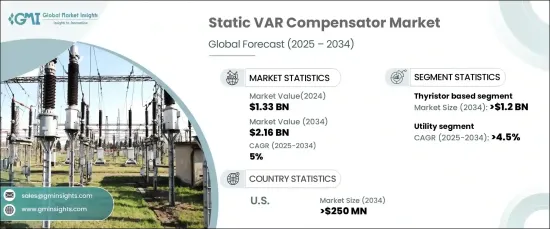PUBLISHER: Global Market Insights Inc. | PRODUCT CODE: 1667061

PUBLISHER: Global Market Insights Inc. | PRODUCT CODE: 1667061
Static VAR Compensator Market Opportunity, Growth Drivers, Industry Trend Analysis, and Forecast 2025 - 2034
The Global Static VAR Compensator Market achieved a valuation of USD 1.33 billion in 2024 and is set to grow at a CAGR of 5% from 2025 to 2034. This growth is fueled by the increasing integration of renewable energy sources into power grids and the escalating demand for reactive power control to maintain grid stability. As renewable energy adoption accelerates, the need for advanced systems like SVCs to stabilize voltage levels and ensure seamless grid integration becomes critical. SVCs are indispensable in minimizing voltage fluctuations and optimizing power factor correction, enhancing the overall reliability of electricity supply. Additionally, growing investments in power grid modernization and expanding electricity networks across both developed and emerging economies contribute to the market's positive outlook.

Market dynamics further indicate a robust demand for SVCs across utility, industrial, and renewable energy sectors. The rise of smart grids, coupled with the push for energy-efficient solutions, is prompting governments and private stakeholders to deploy advanced technologies. Industries with high electricity consumption are increasingly relying on SVCs to meet energy regulations and reduce operational costs. Furthermore, the growing focus on sustainable energy practices worldwide is paving the way for more widespread adoption of these devices.
| Market Scope | |
|---|---|
| Start Year | 2024 |
| Forecast Year | 2025-2034 |
| Start Value | $1.33 Billion |
| Forecast Value | $2.16 Billion |
| CAGR | 5% |
The thyristor-based static VAR compensator segment is expected to generate USD 1.2 billion by 2034, driven by the pressing need for reactive power regulation and voltage stability across power grids. These systems are integral to ensuring uninterrupted power supply by mitigating voltage fluctuations and addressing power factor concerns. As industrialization continues to gain momentum in emerging markets, the demand for such compensators is anticipated to grow significantly. Industries heavily reliant on consistent and stable power, such as manufacturing and heavy equipment operations, view thyristor-based SVCs as a solution for improving efficiency and avoiding costly disruptions.
The utility-based SVC segment is projected to expand at a CAGR of 4.5% through 2034. Utilities worldwide are making substantial investments to upgrade and expand aging power infrastructure. SVCs play a vital role in these upgrades, enhancing grid stability, reliability, and efficiency. By improving power quality, reducing energy losses, and mitigating penalties for low power factors, these systems address key challenges faced by utilities. As energy costs rise, utilities are increasingly adopting SVCs to optimize grid performance and lower operational expenses.
In the United States, the static VAR compensator market is forecasted to reach USD 250 million by 2034. The push to modernize outdated power infrastructure and integrate renewable energy sources is a significant growth driver. Efforts to enhance grid stability, minimize energy losses, and meet surging electricity demand are fueling adoption across utility and industrial sectors. Additionally, government incentives promoting energy efficiency and smart grid development are accelerating the deployment of SVC systems, positioning the US market for sustained growth over the coming years.
Table of Contents
Chapter 1 Methodology & Scope
- 1.1 Market scope & definitions
- 1.2 Market estimates & forecast parameters
- 1.3 Forecast calculation
- 1.4 Data sources
- 1.4.1 Primary
- 1.4.2 Secondary
- 1.4.2.1 Paid
- 1.4.2.2 Public
Chapter 2 Executive Summary
- 2.1 Industry synopsis, 2021 - 2034
Chapter 3 Industry Insights
- 3.1 Industry ecosystem analysis
- 3.2 Regulatory landscape
- 3.3 Industry impact forces
- 3.3.1 Growth drivers
- 3.3.2 Industry pitfalls & challenges
- 3.4 Growth potential analysis
- 3.5 Porter's analysis
- 3.5.1 Bargaining power of suppliers
- 3.5.2 Bargaining power of buyers
- 3.5.3 Threat of new entrants
- 3.5.4 Threat of substitutes
- 3.6 PESTEL analysis
Chapter 4 Competitive Landscape, 2024
- 4.1 Introduction
- 4.2 Strategic outlook
- 4.3 Innovation & sustainability landscape
Chapter 5 Market Size and Forecast, By Product, 2021 – 2034 (USD Million)
- 5.1 Key trends
- 5.2 Thyristor-based
- 5.3 MCR-based
Chapter 6 Market Size and Forecast, By Application, 2021 – 2034 (USD Million)
- 6.1 Key trends
- 6.2 Utility
- 6.3 Railway
- 6.4 Industrial
- 6.5 Oil & gas
- 6.6 Others
Chapter 7 Market Size and Forecast, By Region, 2021 – 2034 (USD Million)
- 7.1 Key trends
- 7.2 North America
- 7.2.1 U.S.
- 7.2.2 Canada
- 7.2.3 Mexico
- 7.3 Europe
- 7.3.1 Germany
- 7.3.2 France
- 7.3.3 Russia
- 7.3.4 UK
- 7.3.5 Italy
- 7.3.6 Spain
- 7.3.7 Netherlands
- 7.3.8 Austria
- 7.4 Asia Pacific
- 7.4.1 China
- 7.4.2 Japan
- 7.4.3 South Korea
- 7.4.4 India
- 7.4.5 Australia
- 7.4.6 New Zealand
- 7.4.7 Malaysia
- 7.4.8 Indonesia
- 7.5 Middle East & Africa
- 7.5.1 Saudi Arabia
- 7.5.2 UAE
- 7.5.3 Qatar
- 7.5.4 Egypt
- 7.5.5 South Africa
- 7.5.6 Nigeria
- 7.5.7 Kuwait
- 7.5.8 Oman
- 7.6 Latin America
- 7.6.1 Brazil
- 7.6.2 Argentina
Chapter 8 Company Profiles
- 8.1 ABB
- 8.2 American Superconductor
- 8.3 Clariant Power System
- 8.4 Delta Electronics
- 8.5 Eaton
- 8.6 Elco Power
- 8.7 General Electric
- 8.8 Hitachi Energy
- 8.9 JEMA Energy
- 8.10 Komachine
- 8.11 Merus Power
- 8.12 Mitsubishi Electric
- 8.13 Nidec Industrial Solutions
- 8.14 NISSIN ELECTRIC
- 8.15 NR Electric
- 8.16 RXPE
- 8.17 Siemens
- 8.18 Sieyuan Electric
- 8.19 Toshiba Energy Systems & Solutions Corporation
- 8.20 Wartsila




